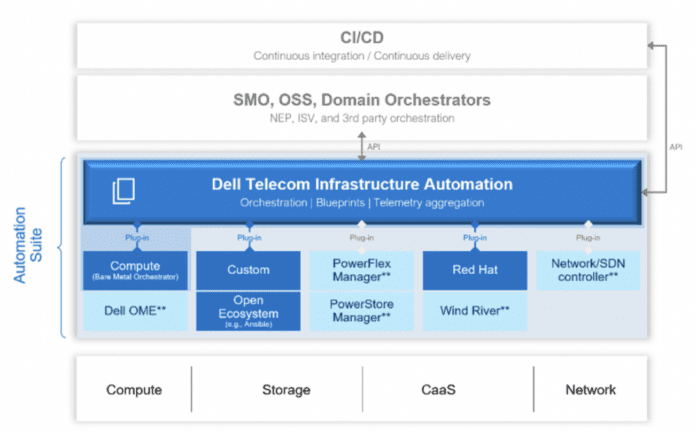
By Sean Kinney, Editor in Chief February 25, 2024
Collected at: https://www.rcrwireless.com/20240225/5g/dell-takes-on-5g-core-multi-vendor-infrastructure-automation
From vertical stacks to open, horizontal networks
As it continues to grow its Telecom Systems Business, Dell Technologies announced ahead of Mobile World Congress in Barcelona solutions that address ongoing operator efforts to broadly modernize, cloudily and automate network infrastructure and management processes. Dell’s telecom story, and product set, have quickly ramped from focuses on grabbing Open RAN deals as a server infrastructure provider and private network business also with a hardware-centric pitch. The breadth of its offerings, and the partner ecosystem around it, have grown to now include infrastructure automation software and a distributed 5G core offering. The big theme here is around leveraging Dell’s existing expertise in cloud hardware and software, as well as its global services organization, to help operators simplify the move to cloud native networks and operations.
Dell’s SVP and GM of the Telecom Systems Business Dennis Hoffman said in a statement, “The first step in network cloud transformation is installing the cloud infrastructure platform, both architecturally and operationally. It takes a team to successfully address the people, process and technology aspects of these programs. We’re contributing not only our technology, but our years of cloud transformation experience to ecosystem partnerships with communications service providers [CSPs] around the world.”
The big announcements here are the Dell Telecom Infrastructure Automation Suite and advancements to the Dell Telecom Infrastructure Blocks for Red Hat.
Highlights of the automation suite include faster configuration/provisioning with declarative automation for simplified server configuration and software deployment; use of open APIs and Dell services for integration with BSS/OSS solutions; “comprehensive telemetry on equipment temperature, CPU and memory utilization, to help AI operations make more informed decisions on networks operations;” and design/build/support services.
Then the Dell Telecom Infrastructure Blocks for Red Hat combines Dell servers with Red Hat OpenShift and Red Hat Advanced Cluster Management for Kubernetes. The latest includes support for deployment of 5G core functionality at the edge “so CSPs can deploy a validated, consistent cloud platform from the core to the far edge of the network;” integration with the automation suite; and a certification program with partners, including 6D Technologies, Amdocs, Casa Systems, Expeto and MATRIXX Software.
“Laying the groundwork for AIOps”
All of this ties into some the major trends in both technology and business that operators are working to leverage, particularly the move to 5G Standalone, the adoption of cloud native operational processes, networking infrastructure decentralization and enterprise enablement. Dell’s Andrew Vaz, vice president of product management, laid out in a blog how all this connects, what it means for Dell and how the company is addressing it from product and services perspectives.
“We’re increasingly asked by our telecom customers how to cloudify the telecom network and reap the economic and agility benefits of such a transformation. And we realized we needed to invest in a set of software tools at the infrastructure layer to make the benefits seen in various verticals true in the telecom environment…In telecom networks, automation has long played an essential role. But as infrastructure transforms from tightly integrated vertical stacks to open, horizontal layers, the number of moving parts that must work together goes way up. What was once a mostly single-vendor environment is made up of technologies from multiple vendors throughout the stack. The only way to overcome this complexity and reap the benefits of a modern telco cloud—flexibility, agility, efficiency—is to deploy vendor-agnostic, comprehensive automation that integrates into your operating environment.”
Enter the automation suite which ticks the boxes of vendor-agnostic, software-centric and management/orchestration of open infrastructure. The solution, Vaz wrote, “seamlessly orchestrates domain-specific infrastructure controllers, promoting cross-domain automation and bridging the vertical silos that once existed in telecom environments. This integration capability allows for seamless operation with existing OSS/BSS systems, preventing the creation of new automation islands. In addition, the suite includes a controller for automating the deployment and lifecycle management of bare metal servers, consolidates inventory and aggregates infrastructure telemetry, laying the groundwork for AIOps.”

Leave a Reply